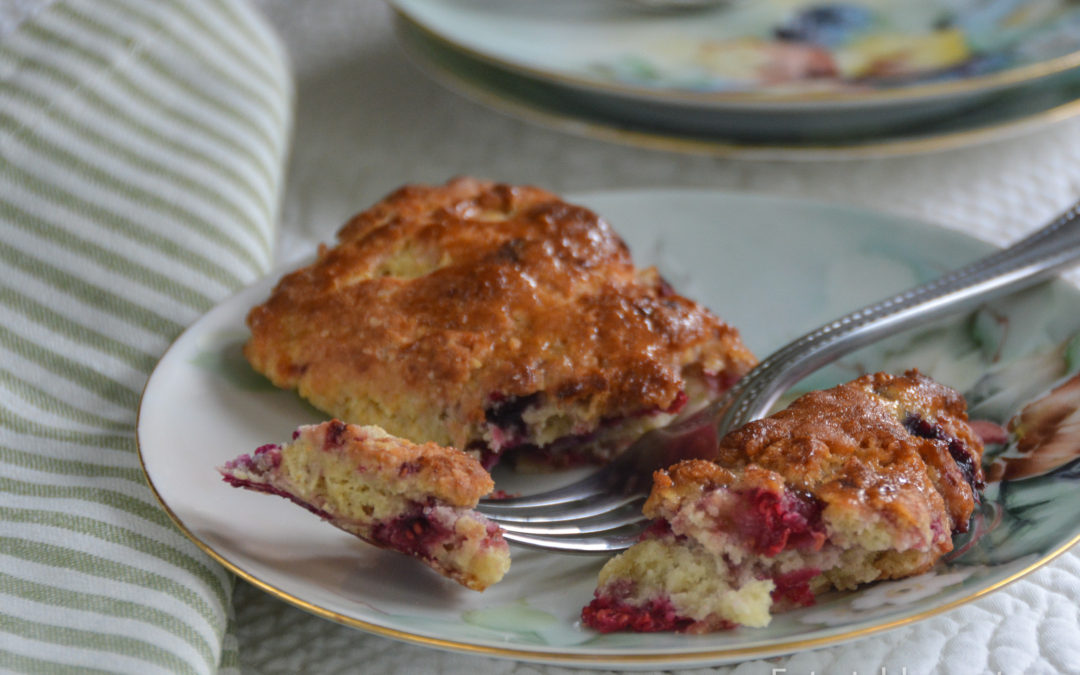This recipe, very slightly adapted from Cook’s Country, is a winner. The tartness of the berries is offset beautifully by a touch of sweetness in the butter and honey glaze.
These American-style, big, shaggy scones are easy to make and fill the house with the most delightful aroma while baking. Serve them on a weekend morning and your family and guests will be delighted; the best part is they’re made with frozen berries, so can be prepared on a moment’s notice. They’re a perfect accompaniment to a plate of scrambled eggs or a bowl of plain greek yoghurt for breakfast, or as the star attraction for an afternoon tea.
Tossing the berries in confectioner’s sugar stops a lot of the bleeding into the scone so you end up with a nice visual distinction between the flaky scone and the moist berry portion. Yum, yum, yum.

Mixed Berry Scones
A scrumptious scone bursting with berries—perfect for breakfast, an afternoon snack or tea.
Ingredients
For the scones
- 285 g or 1 ¾ c frozen mixed berries (I used raspberry and blueberry)
- 22 g or 3 tbsp confectioners’ sugar
- 360 g or 3 c all-purpose flour
- 170 g or 6 oz unsalted butter, cut into ½ inch pieces, divided in half (keep chilled)
- 67 g or 1/3 c granulated sugar
- 1 tbsp baking powder
- 1 ¼ tsp salt
- 210 g or 7 oz milk
- 1 large egg plus 1 large egg yolk
For the glaze
- 1 ounce or 2 tbsp unsalted butter, melted
- 1 tbsp honey
Instructions
Preparation
- Adjust oven rack to upper-middle position and heat oven to 425 degrees—Line a rimmed baking sheet with parchment paper.
- If your berry mix contains strawberries, cut them in half. Toss berries with confectioners’ sugar in a bowl; freeze until needed.
To make the scones
- In the bowl of a food processor, combine the flour, 85 g or 3 oz of butter, granulated sugar, baking powder, and salt. Process until the butter is fully incorporated (15 seconds). Add the remaining butter and pulse until the butter is reduced to pea-size pieces (12 to 15 pulses).
- Transfer the mixture to a large bowl and gently stir in the berries.
- In a medium bowl, beat the milk, whole egg and egg yolk together. Make a well in the centre of the flour mixture and pour in the milk mixture. Using a rubber spatula, gently fold the mixture, scraping from the edges of the bowl and folding inward until a very shaggy dough forms and some bits of flour remain. Do not overmix.
- Turn out the dough onto a well-floured counter. Flour your hands—this part is very messy. Knead the dough briefly until it just comes together (about 3 turns). Using your floured hands and a bench scraper, shape the dough into a 12 by 14-inch rectangle, about 1½ inches tall. Using a knife or bench scraper, cut the dough vertically into 4 equal rectangles*. Cut each rectangle diagonally into 2 triangles (you should have 8 scones total).
- Transfer the scones to the prepared sheet and bake until the scones are lightly golden on top (16 to 18 minutes), rotating the pan halfway through baking.
To make the glaze
- While the scones are baking, combine the melted butter and honey in a small bowl.
- Remove the scones from the oven and brush the tops evenly with the glaze mixture. Return the scones to the oven and bake until golden brown on top (5 to 8 minutes longer).
- Transfer the scones to a wire rack and let cool for at least 10 minutes before serving.
To make ahead
- Unbaked scones can be frozen for several weeks. After cutting them into triangles, you can freeze them on a baking sheet. Once frozen, they can be transferred to a zip-lock freezer bag. When ready to bake, heat the oven to 375 degrees and extend the cooking time in the first baking to 26 minutes. Baking time after the glaze is applied will remain at 5 to 8 minutes.
Notes
- Tossing the frozen berries in confectioner’s sugar keeps them from bleeding into the dough.
- The two-step butter incorporation process produces a lighter and flakier scone, as the small lumps of butter from the second, briefer whir in the food processor creates pockets of steam.
- The glaze adds a lovely bit of sweet crispness to the finished scone.
- *The scones are quite large. If you want smaller ones, cut the rectangle into three vertical pieces, then cut those in half horizontally, to make six rectangles. Cut each rectangle diagonally to make 12 scones, rather than 8.
America’s Test Kitchen and its sister site, Cook’s Country, provide wonderful, fully tested recipes. I love the detailed explanations as to what works and why. The original recipe is here. There’s a video on how to make the scones and a good deal more of the science on the site.
My only quibble is that they sometimes over-engineer things so the recipes are a shade more complicated than they need to be; complex steps have introduced minimal or no difference to the end product but have added significantly to the prep time. But you can be confident that they’ve tried every permutation and combination to arrive at the finished product.
Sharing with Between Naps on the Porch.







I’ve been looking for a good scone recipe since I left the UK and I can trust that yours is delish. One thing, what is a bench scraper? I like the idea you can freeze and bake when needed! Thanks for sharing.
These are American Scones, Maura, so bigger than you’re used to. I’d suggest going with the 12, rather than the cut for 8. Delicious, though!
Almost forgot – a bench scraper is a nifty kitchen tool, very useful for scraping up sticky doughs and sturdy enough to slice with deep, clean cuts. Here’s a link to one on Amazon: https://www.amazon.com/Norpro-Stainless-Steel-Scraper-Chopper/dp/B000SSZ4Q4/ref=sr_1_5?crid=94ESEKS385I0&keywords=bench+scraper&qid=1560858074&s=gateway&sprefix=bench+scraper%2Caps%2C139&sr=8-5
These scones look so delicious, I saw this on BNOTP Met Monday. I am gonna try this recipe using my homegrown blueberries, yum.
Ooooh! That’ll add an even better flavour. Homegrown blueberries are delish. You might want to freeze them first, Jo. They don’t burst as quickly in the oven, so retain their shape better. Good luck!
These scones are phenomenal! Eat them while they are still warm, it a carnival of flavor for your whole body.
★★★★★
Boy oh boy, these look gooood!